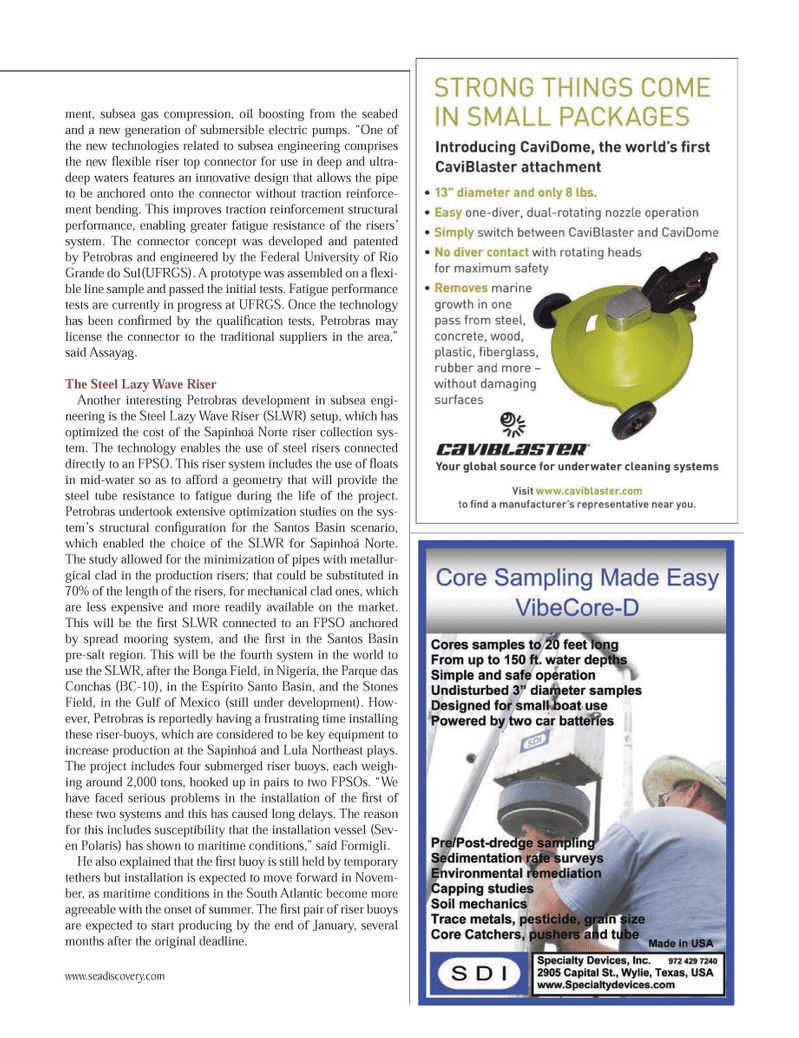
Page 41: of Marine Technology Magazine (November 2013)
Fresh Water Monitoring & Sensors
Read this page in Pdf, Flash or Html5 edition of November 2013 Marine Technology Magazine
ment, subsea gas compression, oil boosting from the seabed and a new generation of submersible electric pumps. ?One of the new technologies related to subsea engineering comprises the new exible riser top connector for use in deep and ultra- deep waters features an innovative design that allows the pipe to be anchored onto the connector without traction reinforce-ment bending. This improves traction reinforcement structural performance, enabling greater fatigue resistance of the risers? system. The connector concept was developed and patented by Petrobras and engineered by the Federal University of Rio Grande do Sul(UFRGS). A prototype was assembled on a exi- ble line sample and passed the initial tests. Fatigue performance tests are currently in progress at UFRGS. Once the technology has been con rmed by the quali cation tests, Petrobras may license the connector to the traditional suppliers in the area,? said Assayag.The Steel Lazy Wave Riser Another interesting Petrobras development in subsea engi- neering is the Steel Lazy Wave Riser (SLWR) setup, which has optimized the cost of the Sapinhoá Norte riser collection sys-tem. The technology enables the use of steel risers connected directly to an FPSO. This riser system includes the use of oats in mid-water so as to afford a geometry that will provide the steel tube resistance to fatigue during the life of the project. Petrobras undertook extensive optimization studies on the sys- tem?s structural con guration for the Santos Basin scenario, which enabled the choice of the SLWR for Sapinhoá Norte. The study allowed for the minimization of pipes with metallur- gical clad in the production risers; that could be substituted in 70% of the length of the risers, for mechanical clad ones, which are less expensive and more readily available on the market. This will be the rst SLWR connected to an FPSO anchored by spread mooring system, and the rst in the Santos Basin pre-salt region. This will be the fourth system in the world to use the SLWR, after the Bonga Field, in Nigeria, the Parque das Conchas (BC-10), in the Espírito Santo Basin, and the Stones Field, in the Gulf of Mexico (still under development). How- ever, Petrobras is reportedly having a frustrating time installing these riser-buoys, which are considered to be key equipment to increase production at the Sapinhoá and Lula Northeast plays. The project includes four submerged riser buoys, each weigh- ing around 2,000 tons, hooked up in pairs to two FPSOs. ?We have faced serious problems in the installation of the rst of these two systems and this has caused long delays. The reason for this includes susceptibility that the installation vessel (Sev- en Polaris) has shown to maritime conditions,? said Formigli. He also explained that the rst buoy is still held by temporary tethers but installation is expected to move forward in Novem- ber, as maritime conditions in the South Atlantic become more agreeable with the onset of summer. The rst pair of riser buoys are expected to start producing by the end of January, several months after the original deadline.www.seadiscovery.com MTR #9 (34-49).indd 41MTR #9 (34-49).indd 4112/13/2013 9:35:08 AM12/13/2013 9:35:08 AM

 40
40

 42
42
